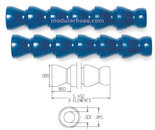mattaphore
Contributor
Hey all you DIYers,
I (graduate student on modest income) have started building a tray and lighting arms for my point & shoot Ikelite underwater camera housing. I've machined my tray out of Delrin and I'm going to be securing some PVC piping to make some lighting arms... (I'll also soon be spec'ing out some high power LEDs/drivers for my lights).
Doing a quick search for ball socket arms, I found that the professional setups easily cost 100s of dollars. I've been tempted to pull apart a Joby Gorillapod and use the legs as bendable lighting arms but then I found these: Aquarium Ball Socket Tubes, and I was wondering if anyone aquarists out there has experience with these.
A little more digging around the web led me to Modularhose.com, who makes the "Loc-Line" stuff for about $6 per foot. It looks pretty sturdy and it's meant for all sorts of industrial applications like coolant fluid jets for cutting tools... and at $6/ft it's a lot cheaper than Ikelite's ball-socket arms.

Seems like it would do the same job and it's meant for handling aquarium water, so salt water shouldn't be a problem. I'm not sure how easily the tubing pulls apart, but I figure running a length of 550-paracord through the tubing and tying it off on either end should keep it from coming apart.
Hopefully with a bit of machining in my school's machine shop, I should be able to save a couple bucks Also, if I end up getting the Loc-Line, I'll update you all on how it goes.
Also, if I end up getting the Loc-Line, I'll update you all on how it goes.
I (graduate student on modest income) have started building a tray and lighting arms for my point & shoot Ikelite underwater camera housing. I've machined my tray out of Delrin and I'm going to be securing some PVC piping to make some lighting arms... (I'll also soon be spec'ing out some high power LEDs/drivers for my lights).
Doing a quick search for ball socket arms, I found that the professional setups easily cost 100s of dollars. I've been tempted to pull apart a Joby Gorillapod and use the legs as bendable lighting arms but then I found these: Aquarium Ball Socket Tubes, and I was wondering if anyone aquarists out there has experience with these.
A little more digging around the web led me to Modularhose.com, who makes the "Loc-Line" stuff for about $6 per foot. It looks pretty sturdy and it's meant for all sorts of industrial applications like coolant fluid jets for cutting tools... and at $6/ft it's a lot cheaper than Ikelite's ball-socket arms.

Seems like it would do the same job and it's meant for handling aquarium water, so salt water shouldn't be a problem. I'm not sure how easily the tubing pulls apart, but I figure running a length of 550-paracord through the tubing and tying it off on either end should keep it from coming apart.
Hopefully with a bit of machining in my school's machine shop, I should be able to save a couple bucks




